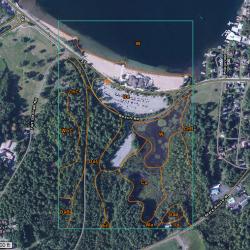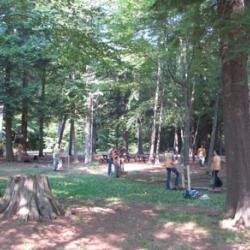One of the first things archaeologists seek to understand when they are investigating a site is the stratigraphy. This entails both documentary research and ground-truthing through test excavations like shovel test pits (STPs) or small excavation units. At its most basic, stratigraphy is...
Million Dollar Beach Site
Archaeological Excavations in the Village of Lake George, NY
The Million Dollar Beach Site is a multi-component archaeological site directly adjacent to the famous waterfront in the Village of Lake George. Limited excavations of the site toward the goal of better preserving it in place while maintaining use of the beach parking lot, road, and campground, are currently underway in a collaborative effort between the New York State Museum’s Cultural Resource Survey Program and the Department of Environmental Conservation.
Project Directors: Barry Dale, Aaron Gore and Steve Morange
Project Updates
Stratigraphy is the analysis of strata or soil layers. Some areas, like rocky escarpments, may have very limited or no soil and others, like active flood plains, may have dozens of feet before you’d reach bedrock. In the latter situation, sediment deposited by flooding and acted upon by other...
Context and Association are the two most important concepts in archeology. Put simply, they ask, where was an object (or feature or site) found and what was found with it? For an archaeologist to make an educated interpretation about what an artifact means, they need to know as much as possible...
Understanding the stratigraphy of the Million Dollar Beach Site helps us to build a case for the context and associations of the artifacts we find there. This process began even before we set foot in the field by researching what soils we should expect. Figure 2 is an image taken from the...
At the Million Dollar Beach Site there are two main divisions to the soils we encountered: natural soils, and soils that were affected by some sort of modern disturbance. The first set of soils includes most of the site and the majority of the campground area. The second set of soils includes...
Disturbed soils ranged in their appearance and form and included long, linear features created by buried electrical lines to large pit features which included a fifty-year-old septic tank. One particular disturbance that deserves further mention here is the work done around the road as it...
It was deemed likely during the initial set up of the survey that identified the Million Dollar Beach Site that the areas underneath the road, parking lot, and median between the two would have been heavily disturbed by their construction and therefore, even if the original soil was still there...
The Million Dollar Beach Site was identified in August of 2013 during a survey of the area around the DEC parking lot and campground prior to road improvements (see Photo 1). This survey proceeded directly into limited test excavations after the discovery of almost 2,000 prehistoric artifacts...





